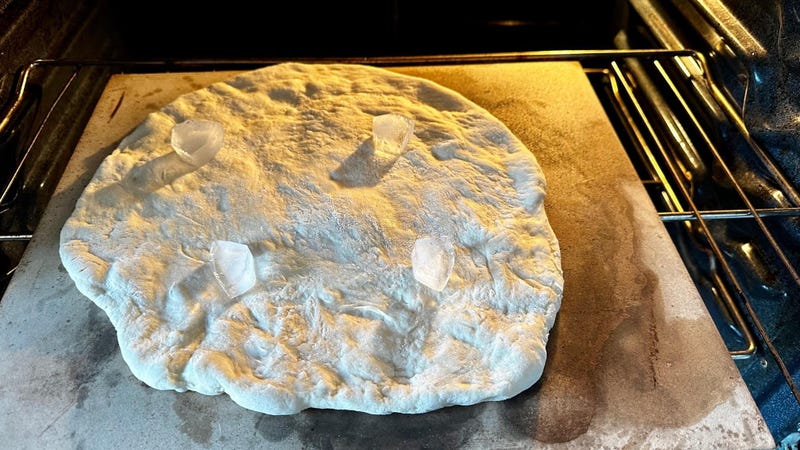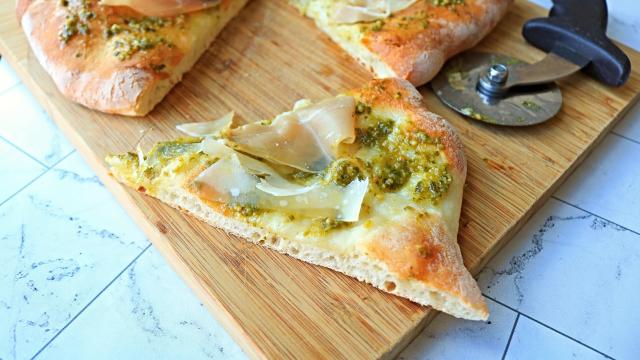“Naked pizza” might sound confusing at first, if not slightly scandalous. After all, half of the fun is adding flavorful toppings, so what is the allure of nude dough? A naked pizza is more than its title; think of it as a starting point for alternative toppings. The technique is simple, but you’re going to need some ice cubes.
Why you should make a naked pizza
A naked pizza is, at its most basic, pizza dough that is baked unclad, un-topped, nude. Toppings are usually added after baking. This could be a simple smear of garlic and olive oil, or something more elaborate like a spoonful of fresh pesto, shaved parmesan, and a heap of arugula salad with orange segments. This type of pizza is great for folks that don’t enjoy the typical saucy pizza, or those avoiding heaps of melted cheese.
It’s also the best pizza for delicate toppings. Anything that wouldn’t do well lingering in an oven heater to 200°C or higher can be added after baking the dough. You can add ribbons of delicate cured meats, like prosciutto, or rosettes of thinly shaved mortadella, as well as fresh herbs or fresh fruit slices that would scorch under in a super hot oven.

Why ice cubes work
The trouble with baking pizza bare pizza dough is that it lacks protection. The sauce and cheese normally create a hydrated barrier that keeps the surface of the dough moist and stretchy while the bottom crisps and browns. Without that covering, the dough is exposed on the surface, and will immediately start to dry out and crisp up. While this won’t result in something inedible, the texture is all wrong for a pizza, naked or otherwise. Ice cubes shield your dough and impart moisture, without adding any flavor of their own.
The ice cubes melt and create a watery slick over the top of the crust. This does a couple helpful things. The evaporating water adds humidity to the oven air, preventing a hard skin from developing before the dough fully expands. This allows for maximum “oven spring,” which occurs when yeasted bread does a final rise in the oven. The surface of the crust stays moist, while the bottom of the crust browns. By the time the ice cubes melt and the last puddles dry up, the pizza crust is fully cooked on the bottom, and tender on top.
How to make a naked pizza
Prepare your pizza dough, either homemade or store-bought. If using store-bought, follow the manufacturer’s instructions before stretching it into your desired shape.
Stretch out the dough
Gently stretch out the pizza dough to the desired size, using the backs of your hands to ensure you don’t poke any holes. Place the dough on a pizza peel that’s been dusted with a little flour, cornmeal, parchment paper, or even crushed potato chips, to keep the dough from sticking. You can do this on a sheet pan too, but the thin metal tends to warp at high temperatures, and pizza stones and baking steels produce a superior crust. If you don’t have a stone or a steel, use a cast iron skillet as an excellent plan B.
Launch the pizza
Set three or four ice cubes in a bowl by the oven. You want them ready so you can top the pie quickly and close the oven up to conserve the heat. If you’re using a pizza peel, slide the pizza into the oven onto the baking surface. Using an oven mitt, pull the rack out of the oven a bit so you don’t have to put your whole arm in there.
Top with ice cubes
Distribute the ice cubes evenly around the surface of the pie, a couple inches from the edge. Gently press them into the dough so they don’t all surf into the center. Push the rack back into the oven, and close the door. Bake until the crust is fully risen and the edges have browned, about 12 minutes at 220°C. The areas where the ice cubes were placed should now be dry, but not browning.
Remove the pizza from the oven with a pizza peel, or quick hands and a cutting board, and allow it to cool on a wire rack. Dress your naked pizza in something decent for once. Try a salad pizza, maybe a swipe of cream cheese with lox and capers, or scatter some sliced persimmons on top with a broken ball of creamy burrata.

Leave a Reply
You must be logged in to post a comment.